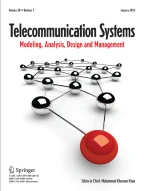Abstract
This paper investigates the use of punctured recursive systematic convolutional codes for turbo coding in a 2-user binary adder channel (2-BAC) in the presence of additive white Gaussian noise, aiming to achieve a higher transmission sum rate with reduced decoding complexity. The encoders for the 2-BAC are assumed to be block synchronized and to employ identical puncturing patterns. Iterative decoding combining the Bahl Cocke Jelinek Raviv algorithm and a two-user punctured trellis is employed. For each user and for a fixed puncturing pattern, random interleavers of length 256 bits or 1024 bits, respectively, are simulated and corresponding curves relating bit error rate versus signal to noise ratio are presented for performance comparison purposes. Computer simulation indicates that the loss in performance of a punctured turbo code can be negligible when longer interleavers are used for both users, similarly to the single user case.
Similar content being viewed by others
Explore related subjects
Discover the latest articles, news and stories from top researchers in related subjects.References
Kasami, T., & Lin, S. (1976). Coding for a multiple-access channel. IEEE Transactions on Information Theory, 2(22), 129–137.
Cain, J. B., Clark, G. C, Jr., & Geist, J. M. (1979). Punctured convolutional codes of rate \((n-1)/n\) and simplified maximum likelihood decoding. IEEE Transactions on Information Theory, 25(1), 97–100.
Wicker, S. B. (1995). Error control systems for digital communication and storage. Upper Saddle River, NJ: Prentice Hall.
Bisla, J. K., Dhillon, N., & Sharma, K. (2014). Performance evaluation of punctured convolutional codes for OFDM-WiMAX system. International Journal of Electronics and Electrical Engineering, 2(3), 142–148.
Mattas, M., & Ostergard, P. R. J. (2005). A new bound for the zero-error capacity region of the two-user binary adder channel. IEEE Transactions on Information Theory, 51, 3289–3291.
Kiviluoto, L., & Ostergard, P. R. J. (2007). New uniquely decodable codes for the t-user binary adder channel with \(3 \le t \le 5\). IEEE Transactions on Information Theory, 53, 1219–1220.
Roumy, A., & Declerq, D. (2007). Characterization and optimization of LDPC codes for the 2-user Gaussian multiple access channel. EURASIP Journal on Wireless Communications and Networking, 2007, 1–10.
Beltrão Neto, H. V., & da Rocha Jr., V. C. (2009). Iterative decoding results for the Gaussian multiuser binary adder channel. In Proceedings of tenth international symposium on communication theory and applications (pp. 1–6).
Wang, G., Land, I., & Grant, A. (2012). Irregular repeat accumulate codes with few iterations for the binary adder channel. In Proceedings of 7th international symposium on turbo codes and iterative information processing (ISTC 2012) (pp. 215–219).
Lu, S., Cheng, J., & Hou, W., et al. (2013). Generalized construction of signature code for multiple-access adder channel. In Proceedings of IEEE international symposium on information theory (ISIT 2013) (pp. 1655–1659).
Matsuda, H. (2013). Coding for a noisy binary multiple-access adder channel. American Journal of Computational and Applied Mathematics, 3(1), 23–25.
Alcoforado, M. L. M. G., Oliveira, M. C. C., & da Rocha, V. C, Jr. (2015). The Bahl-Cocke-Jelinek-Raviv decoding algorithm applied to the three-user binary adder channel. IET Communications, 9(7), 897–902.
Bahl, L. R., Cocke, J., Jelinek, F., et al. (1974). Optimal decoding of linear codes for minimizing symbol error rate. IEEE Transactions on Information Theory, 2(20), 284–287.
Khalid, A., Khan, E., Adebisi, B., et al. (2015). Image transmission using unequal error protected multi-fold turbo codes over a two-user power-line binary adder channel. IET Image Processing, 9(5), 395–404.
Peterson, R., & Costello, D. J, Jr. (1979). Binary convolutional codes for a multiple-access channel. IEEE Transactions on Information Theory, 25(1), 101–105.
Alcoforado, M. L. M. G., da Rocha, V. C, Jr., Markarian, G., et al. (2011). Iterative decoding of turbo convolutional codes over noisy two-user binary adder channel. Electronics Letters, 13(47), 749–751.
Berrou, C., Glavieux, A., & Thitimajshima, P. (1993). Near Shannon limit, error-correcting coding and decoding: turbo codes. In Proceedings of IEEE international conference on communications, (ICC’93), 2/3 (pp. 1064–1071).
Alcoforado, M. L. M. G., & da Rocha, V. C, Jr. (2010). The Bahl-Cocke-Jelinek-Raviv algorithm applied to the two user binary adder channel. Journal of Communication and Information Systems, 25, 30–35.
Heegard, C., & Wicker, S. (1999). Turbo coding. Berlin: Kluwer Academic Publishers.
Acknowledgments
V. C. da Rocha Jr. acknowledges partial support from the Brazilian National Council for Scientific and Technological Development - CNPq under grant number 304696/2010-2. The authors are grateful to the reviewers for their comments and suggestions which helped improving the contents of this article.
Author information
Authors and Affiliations
Corresponding author
Rights and permissions
About this article
Cite this article
Alcoforado, M.d.L.M.G., de Jesus, J.J.C.B. & da Rocha, V.C. Turbo coding for the noisy 2-user binary adder channel with punctured convolutional codes. Telecommun Syst 64, 459–465 (2017). https://doi.org/10.1007/s11235-016-0185-z
Published:
Issue Date:
DOI: https://doi.org/10.1007/s11235-016-0185-z
